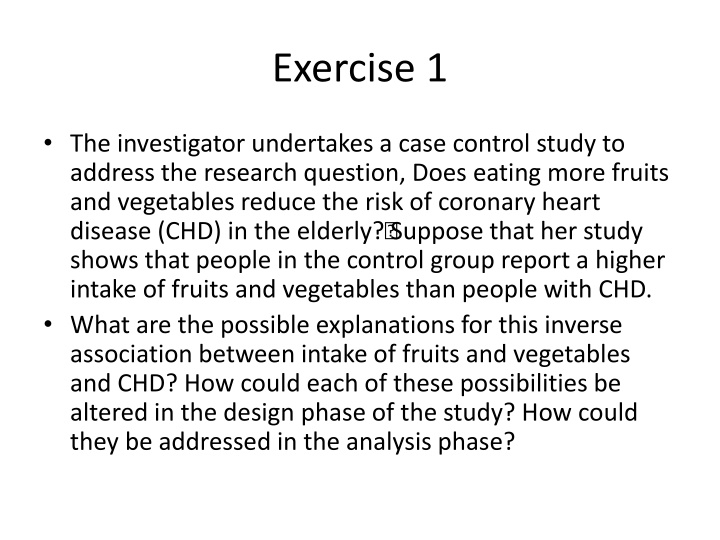
Research Studies on Diet, Health, and Diagnostic Testing
Explore two detailed research exercises focusing on the impact of diet on coronary heart disease and the use of erythrocyte sedimentation rate in diagnosing pelvic inflammatory disease in women. Learn about study design, confounders, biases, sampling methods, and result interpretation in epidemiology.
Download Presentation

Please find below an Image/Link to download the presentation.
The content on the website is provided AS IS for your information and personal use only. It may not be sold, licensed, or shared on other websites without obtaining consent from the author. If you encounter any issues during the download, it is possible that the publisher has removed the file from their server.
You are allowed to download the files provided on this website for personal or commercial use, subject to the condition that they are used lawfully. All files are the property of their respective owners.
The content on the website is provided AS IS for your information and personal use only. It may not be sold, licensed, or shared on other websites without obtaining consent from the author.
E N D
Presentation Transcript
Exercise 1 The investigator undertakes a case control study to address the research question, Does eating more fruits and vegetables reduce the risk of coronary heart disease (CHD) in the elderly? Suppose that her study shows that people in the control group report a higher intake of fruits and vegetables than people with CHD. What are the possible explanations for this inverse association between intake of fruits and vegetables and CHD? How could each of these possibilities be altered in the design phase of the study? How could they be addressed in the analysis phase?
Exercise 1. Give special attention to the possibility that the association between eating fruits and vegetables and CHD may be confounded by exercise (if people who eat more fruits and vegetables also exercise more, and this is the cause of their lower CHD rates). What approaches could you use to cope with exercise as a possible confounder, and what are the advantages and disadvantages of each plan?
Exercise 2 You are interested in studying the erythrocyte sedimentation rate (ESR) as a test for pelvic inflammatory disease (PID) in women with abdominal pain. To do this, you will need to assemble groups of women who do and do not have PID. What would be the best way to sample these women? How might the results be biased if you used final diagnosis of PID as the gold standard and those assigning that diagnosis were aware of the ESR?
Exercise 2 You find that the sensitivity of an ESR of at least 20 mm/hr is 90%, but the specificity is only 50%. On the other hand, the sensitivity of an ESR of at least 50 mm/hr is only 75%, but the specificity is 85%. How should you present these results?
